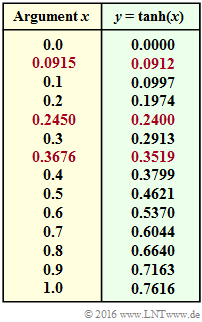Exercise 4.3Z: Conversions of L-value and S-value
We assume a binary random variable $x ∈ \{+1, \, -1\}$ with following probabilities:
- $${\rm Pr}(x =+1) = p\hspace{0.05cm},$$
- $${\rm Pr}(x =-1) = q = 1-p\hspace{0.05cm}.$$
The "reliability" of symbol $x$ can be expressed
- by the L–value $($log likelihood ratio$)$ according to the definition
- $$L(x) = {\rm ln} \hspace{0.2cm} \frac{p}{q} = {\rm ln} \hspace{0.2cm} \frac{p}{1 - p}\hspace{0.05cm} \hspace{0.05cm},$$
- by the so called "S–value":
- $$S(x) = p- q \hspace{0.05cm}.$$
We have created the term "S–value" in order to be able to formulate the following questions more succinctly. In the literature, one sometimes finds the term "soft bit" for this.
As will be shown in subtask (1), $L(x)$ and $S(x)$ can be converted into each other.
Subsequently, these functions shall be used to calculate the following quantities, always assuming a code length $n = 3$:
- the extrinsic L–value for the third symbol ⇒ $L_{\rm E}(x_3)$,
- the a-posteriori L–value for the third symbol ⇒ $L_{\rm APP}(x_3)$.
The calculation should be done for the following codes:
- the repetition Code $\text{RC (3, 1, 3)}$ with the constraint $\sign {(x_1)} = \sign {(x_2)} = \sign {(x_3)}$,
- the single parity–check code ⇒ $\text{SPC (3, 2, 2)}$ with the constraint $x_1 \cdot x_2 \cdot x_3 = +1$.
Hints:
- This exercise belongs to the chapter "Soft–in Soft–out Decoder".
- Reference is made in particular to the section "Reliability Information – Log Likelihood Ratio".
- To solve, you need the "hyperbolic tangent" according to the following definition $($this function is given above in tabular form$)$:
- $$y = {\rm tanh}(x) = \frac{{\rm e}^{+x/2} - {\rm e}^{-x/2}}{{\rm e}^{+x/2} + {\rm e}^{-x/2}} = \frac{1 - {\rm e}^{-x}}{1 + {\rm e}^{-x}} \hspace{0.05cm}.$$
Questions
Solution
- $p = {\rm Pr}(x = +1)$, and
- $p = {\rm Pr}(x=-1) = 1-p$
the following definitions apply:
- $$L(x) = {\rm ln} \hspace{0.2cm} \frac{p}{q} = {\rm ln} \hspace{0.2cm} \frac{p}{1 - p}\hspace{0.05cm} \hspace{0.3cm} \Rightarrow \hspace{0.3cm} -\infty \le L(x) \le +\infty \hspace{0.05cm},$$
- $$S(x) = p- q = 2 \cdot p - 1\hspace{0.05cm} \hspace{0.3cm} \Rightarrow \hspace{0.3cm} -1 \le S(x) \le +1 \hspace{0.05cm}.$$
- Based on the S–value, we get because of $p + q = 1$:
- $$S(x) = p- q = \frac{p- q}{p+ q} = \frac{1- q/p}{1+ q/p} \hspace{0.05cm}.$$
- Simultaneously $q/p = {\rm e}^{-L(x)}$ holds. From this follows:
- $$S(x) = \frac{1- {\rm e}^{-L(x)}}{1+ {\rm e}^{-L(x)}} \hspace{0.05cm}.$$
- Multiplying the numerator and denominator by ${\rm e}^{-L(x)/2}$, we finally get:
- $$S(x) = \frac{{\rm e}^{+L(x)/2}- {\rm e}^{-L(x)/2}}{{\rm e}^{+L(x)/2}+ {\rm e}^{-L(x)/2}} = {\rm tanh}\big [L(x)/2. \big] \hspace{0.05cm}.$$
- The inverse function results in
- $$L(x) = 2 \cdot {\rm tanh}^{-1}[S(x)] \hspace{0.05cm}.$$
- Thus, the proposed solutions 2 and 3 are correct. The table shows the L–value and the S–value for some probabilities $p = {\rm Pr}(x=+1)$.
(2) The "extrinsic L–value" for symbol $x_3$ considers only the "a-priori L–values" $L_{\rm A}(x_1)$ and $L_{\rm A}(x_2)$, but not $L_{\rm A}(x_3)$.
- For the $\text{(3, 1)}$ repetition code, this results in:
- $$L_{\rm E}(x_3) = L_{\rm A}(x_1) + L_{\rm A}(x_2) = 2 + (-1) \hspace{0.15cm} \underline{= +1}\hspace{0.05cm}.$$
(3) Thus, for the "a-posteriori L–value", we obtain:
- $$L_{\rm APP}(x_3) = L_{\rm A}(x_3) + L_{\rm E}(x_3) = 3 + 1 \hspace{0.15cm} \underline{= +4}\hspace{0.05cm}.$$
(4) In the single parity–check code, the corresponding calculation rule is:
- $$L_{\rm E}(x_3) \hspace{-0.15cm} \ = \ \hspace{-0.15cm} 2 \cdot {\rm tanh}^{-1} \hspace{0.05cm} \left [ {\rm tanh}(x_1/2) \cdot {\rm tanh}(x_2/2) \right ] = 2 \cdot {\rm tanh}^{-1} \hspace{0.05cm} \left [ {\rm tanh}(+1) \cdot {\rm tanh}(-0.5) \right ] = 2 \cdot {\rm tanh}^{-1} \hspace{0.05cm} \left [ 0.7616 \cdot (-0.4621) \right ] $$
- $$\Rightarrow \hspace{0.3cm}L_{\rm E}(x_3) \hspace{-0.15cm} \ = \ \hspace{-0.15cm} 2 \cdot {\rm tanh}^{-1} \hspace{0.05cm} \left [ -0.3519 \right ] =-2 \cdot 0.3676\hspace{0.15cm} \underline{= -0.7352}\hspace{0.05cm}.$$
- The result ${\rm tanh}^{-1} (-0.3519) = 0.3676$ was taken from the table on the information page.
(5) For the repetition code of length $n = 3$, the same holds as in subtask (3):
- $$L_{\rm E}(x_3) = L_{\rm A}(x_1) + L_{\rm A}(x_2) = -0.847 +1.382 \hspace{0.15cm} \underline{= +0.535}\hspace{0.05cm}.$$
- The L–values corresponding to the table for subtask (1) were used here, for example ${\rm Pr}(x_1 = +1) = 0.3$ ⇒ $L_{\rm A}(x_1) = -0.847$.
(6) Since here instead of the "a-priori L-values" the "a-priori probabilities" are given,
one comes faster to success in comparison with the subtask (4) on the detour over the "extrinsic S-value".
- We denote the extrinsic probability for the third symbol here by $P_{\rm E}(x_3)$. For this holds:
- $$P_{\rm E}(x_3 = +1) \hspace{-0.15cm} \ = \ \hspace{-0.15cm} P_{\rm A}(x_1 = +1) \cdot P_{\rm A}(x_2 = -1) + P_{\rm A}(x_1 = -1) \cdot P_{\rm A}(x_2 = +1) = 0.3 \cdot (1-0.8) + (1-0.3) \cdot 0.8 = 0.62\hspace{0.05cm}.$$
- This results in for the further variables:
- $$S_{\rm E}(x_3) = P_{\rm E}(x_3 = +1) - P_{\rm E}(x_3 = - 1) = 0.62 -0.38 = 0.24\hspace{0.05cm},$$
- $$L_{\rm E}(x_3) = 2 \cdot {\rm tanh}^{-1} \hspace{0.05cm} \left [ S_{\rm E}(x_3) \right ] = 2 \cdot {\rm tanh}^{-1} \hspace{0.05cm} (0.24) = 2 \cdot 0.245 \hspace{0.15cm} \underline{= +0.49}\hspace{0.05cm}$$

